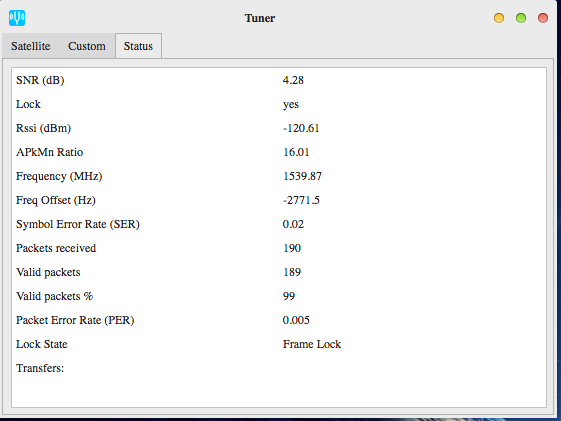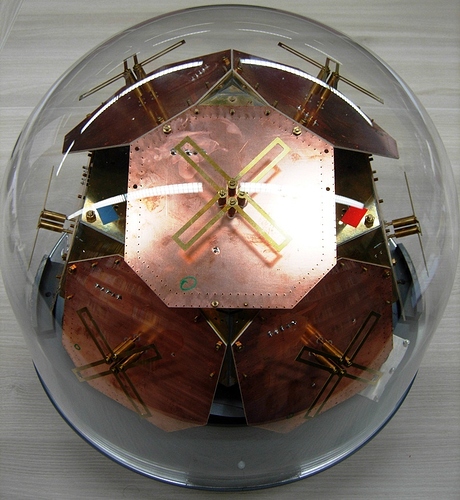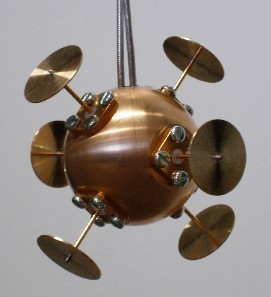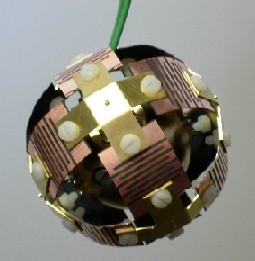Hi. I am a boater/cruiser and particularly interested in receiving weather data (GRIB). I have experience designing stabilized VSAT antennas. Noticed a thread on this topic but lost it after registring but would like to make my contribution based on experience. If the criteria is within 2 degrees accuracy for elevation and azimuth, som type of active solution is required. Also cost and complexity should, in the spirit of things here, be low. A pan/tilt solution is potentially a way to go but introduces complexity in requiring slip-rings for power and RF. A solution that uses the fact that the patch antennas basically has no cost/complexity tickles the concept of several switchable arrays (4). This will only get you into a rough pointing direction requiring finer tracking. This may be accomplished by simple model servos allowing for around ±45 degrees in azimuth and -20 to 90 degrees in elevation. As patches are switched no full rotation occurs. The mechanical complexity is moved to the control domain. With off-the shelf model/robots 9DOF sensors and GPS data, accurate pointing is possible. This will get us to a point where the l-band signal may be picked up and used to peak the RSSI using a simple search pattern. This creates a closed loop lock to the sat. Antenna switching can be done by PIN diode arrangement after LNA but requires good knowledge of RF circuit design. Then you need a MCU and code for the steering of servos and antenna switching.
I looked into this a while ago. It didn’t seem like it would be very difficult, and the cost would be around the $200usd mark. But I decided my money was better spent elsewhere. Keep us updated if you take on this project.
Use a camera gimbal controller for a drone with a brushless gimbal. Power it by an pixhawk clone and put it in a dome.
http://ardupilot.org/plane/docs/common-antenna-tracking.html
You could also get by with an arduino, accelerometer, compass and a couple servos. Put it in a dome with usb and power through a spark fun slip ring. That would cost less but be more work.
I would use a pan and tilt from china for FPV cameras and a arduino for ssomething like this.
But i think that you could simply turn the antenna by hand twice a day or so. A ship is not that fast (im thinking about a big container ship right now) so even when it drives a big distance (accross the ocean) the change for pointing the antenna should not be that much.
@Islander some more informations would be nice about the usecase.
regards,
Manuel
Really depends on the type of boat. A cheap pan tilt will not rotate continuous 360 and you will lose frames. A sailboat or personal boat will go in circles which will need continuous 360 rotation. A small boat will need mounting on cog and brushless gimbal to be able to pitch roll and yaw faster than the boat.
If you’re ok with missing some frames this gets a lot easier.
I was able to get fairly decent signal using a GPS dongle with integrated LNA, modified by removing the GPS filter, bridging the contacts. It didn’t have to be pointed right at the satellite. It was about 3 dB down in SNR form the Outernet patch antenna. That’s a lot, but depending on the initial signal strength and location, say, out in the middle of the ocean, it may not be a problem. In any case, it would greatly simplify aiming to only have to get within 20 degrees or so of the satellite.
What about an array of cheap GPS antennas, say, maybe three, set on a mount at 120 degree angles from each other, and combined to one signal… OR, just a multiple element flat array, with a good LNA.
There seems to be some adjacent satellite traffic around 1539.8725, but nothing right on that frequency.
Thanks all for your input. Tyson, user case is sailyacht(s). Basically the smaller the vessel the more violent the motion. You will have combined roll, pitch, yaw as soon as there is wind and sea. Expect to set requirement to around -+25deg, yaw at ±15 and pitch in same ballpark all in the time span of 5sec. This is why you need “negative” elevation for situations when vessel is on higher latitudes. As most proposals above uses “open loop” control, that is, inertial data it will not work very well over time due to sensordrift and earths rotation. Augmenting with GPS assists to correct some errors. The inertial sensors are really only useful for correction the instanteneous motion. Hence you need to lock on to the sat. As k5ted proposes, switching arrays is more desirable if sufficient SNR is possible with such low-gain antennas.
I think that any kind of directional Antenna is not optimal for a such a small vessel.
A brushlesse gimbal would be fast enough, but the gps could lack behind i think. You also have to process everything and then control the gimbal.
but it would be an interesting project 
regards,
Manuel
Manuel, there are commercially available small VSAT antennas (such as KVH, Thrane and others) that offer Inmarsat broadband connection. These are two or three axis KU band parabolic dishes with a pointing accuracy of less than one degree. These are specifically targeted to the type of boats in question. Thus, it is doable. Thanks to Koopa´s info a slipring for 20USD was found and a plethora of robotic items solves the mechanical challenge. SparkFun has several 9DOF IMU´s, GPS, all in all the hardware and electronics is off-the-shelf, now I need to get in touch with someone that can code… 
but these devices are EXPENSIVE. but nice project, would be nice and cheap alternative to the commercial ones.
PS: i can code if needed  I am a software developer. But i think a local dev would be more easy. Because access to the hardware is sometimes key.
I am a software developer. But i think a local dev would be more easy. Because access to the hardware is sometimes key.
I built and coded a 3 servo controller using a 9DOF IMU and an arduino. I got it to stabilise and track but it does require the signal strength input. Someone on here has already implemented a PWM output hack for signal strength but I didn’t go any further because wifi limitations and power consumption make this unsuitable for my purposes. If support for the RPi3 is confirmed I’ll give it another bash.
If one can get adequate performance with a $8 unfiltered GPS active antenna sitting flat on a windowsill, no metal ground plane underneath, it seems this would be the much more practical, durable and reliable type of antenna, rather than something relying on servos, GPS, a computer, bearings, weatherproof housing, large size, etc. The GPS type ceramic patch antenna approach, at this point, seems to require only more gain, which can be attained with more static mounted patches in an array.
Here’s the hacked GPS antenna direct to the RTL, taken a few minutes ago

I think with the addition of a Inmarsat filter, this would work better.
Agree, avoiding the mechanics is certainly the most desirable option. Surprising that you get such good results as the GPS freqyency is so far away. If it works, it works. What did you hack? Potentially then 2-4 such GPS antenna modules on a groundplane with weather cover and suitable passband filter with combiner (microstrip job) and bias Tee, could improve SNR by 3-6dB. I suspect you need that extra SNR for ruggedness in weather damping and low elevation/ship roll. Very attractive solution. We need to find a filter designer!
Good job! Now that k5ted has a passive/non-mechanical solution I would like to investigate this first before going to the more fun but also more complex and costly stabilized tracking platform. The idea is to come up with something anyone can build so that fellow boaters/cruisers can benefit.
The only hack was to remove the 1575MHz filter, bridge the connection,. and also shortened up the antenna lead to about 5ft. instead of 15ft.
There are readily available and cheap ceramic antennas identical to what is in the active GPS antenna. Granted, they are center tuned about 1560MHz, but have a 100MHz bandwidth. Four or more of these could be mounted on a copper backplane and made into an array with the appropriate matching harness, whether etched into the backplane or with coax. Then, just need a good LNA with Inmarsat filter.
holly molly  so it’s like 3D diversity? Switching to the best RSSI one?
so it’s like 3D diversity? Switching to the best RSSI one?
The second one appears to be the most productizable. Where is it from?
the second and third looks like an isotropic radiotor for satellite, first is a marine military-ish antenna? (that’s just a half hemisphere with biquads?)


